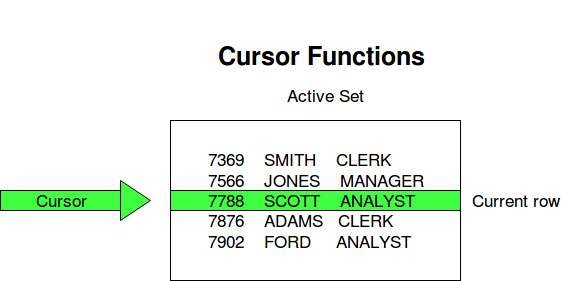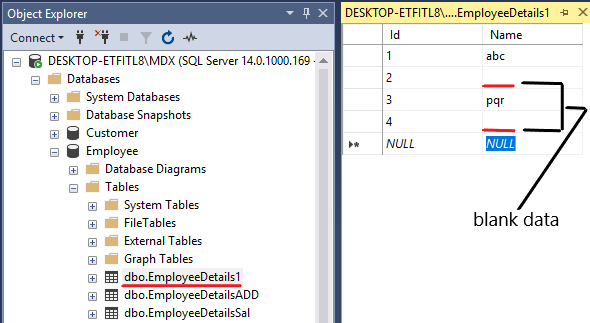A Cursor impacts the performance of the SQL Server since it uses the SQL Server instances memory reduce concurrency decrease network bandwidth and lock resources. Opening the Cursor for storing data retrieved from the result set.

How To Use Update Cursors In Sql Server Codeproject
2000 2005 2008 2008R2 2012.

. Note this tip does not describe the performance aspect of cursor usage. There is no rule but not a standard. June 27 2011.
Hey Folks you might be aware of the Cursor. Well use the produtionproducts table from the sample database to show you how to use a cursor. First declare two variables to hold product name and list price and a cursor to hold the result of a query that retrieves product name and list price from the productionproducts table.
Cursor in SQL is temporary work area created in the system memory thus it occupies memory from your system that may be available for other processes. A SQL cursor is a database object that is used to retrieve data from a result set one row at a time. A SQL Server cursor is a set of T-SQL logic to loop over a predetermined number of rows one at a time.
One last thing is when you work you know but after you your work should give you respect not disrespect. These Cursors are allocated by SQL SERVER when the user performs DML operations. Hence it is mandatory to understand the cursor types and its functions so that you can use suitable cursor according to your needs.
It acts just like a recordset in ASP and Visual Basic. It acts as a loop just like the looping mechanism found in any other programming language like C VBNet C C Java and etc. Disadvantages of using Cursor.
Cursors In SQL Server. In this article we will learn the following. DECLARE CURSOR defines the attributes of a Transact-SQL server cursor such as its scrolling behavior and the query used to build the result set on which the cursor operates.
Working with cursors consists of several steps. Cursors are read-only objects and thus cant update delete or insert data in the database. Cursor in SQL is temporary work area created in the system memory when a SQL statement is executed that allow us to retrieve data from a result set in row by row fashion and used when we want to update records in a database table one row at a time.
My advise related trigger try to avoid and never use cursor in it. Others are welcome to add in andor criticize. - by Piyush Bajaj - 7 Comments.
This enables us to take the actions sequentially eg perform an update on a single row. Once the rows are fetched one by one and manipulated as per requirement the next step is to close the SQL cursor. We use a cursor when we need to update records in a database table in singleton fashion means row by row.
Associate a cursor with the result set of a Transact-SQL statement and define characteristics of the cursor such as. So cursor is used to perform complex logic on row by row basis. Introduction to SQL cursor.
Cursors are database objects used to manipulate data in a set on a row-by-row basis. SQL cursor is asensitive. Execute the Transact-SQL statement to populate.
A SQL cursor is used when the data needs to be updated row by row. Declaring Cursor by defining the SQL statement. Below is probably the most common way of writing a cursor that I have seen.
In SQL server a cursor is used when you need Instead of the T-SQL commands that operate on all the rows in the result set one at a time we use a cursor when we need to update records in a database table in a singleton fashion in other words row by rowto fetch one row at a time or row by row. Cursor is supported in all SQL Server versions ie. The SELECT will return the result to the client and then you would have en endless loop except that it wouldnt compile due to the Table_name doesnt exist so to speak.
Never though and use cursor for capture the data but use when you need the operation of some of rows. Fetch Next from Step 4. When we talk about the SQL cursor it is read-only ie it is not able to update or delete the data.
If not then dont worry I will try to give some heads up. This article explains everything about SQL cursors. Once the cursor is declared and opened the next step is to start retrieving rows from SQL cursor one by one so fetch rows get the next available row from the SQL cursor.
The OPEN statement populates the. Rows can be fetched from the cursor one by one or in a block to do data manipulation. The SQL cursor is non-scrollable ie we can traverse only in one direction.
Anyhow I see three main categories of cursor usage. The examples will focus on the different ways it can be written in SQL Server and some additional description of the structure. You should avoid the use of the cursor.
Why and when use a cursor. The purpose for the cursor may be to update one row at a time or perform an administrative process such as SQL Server database backups in a sequential manner. Explicit Cursors are used for Fetching data from Table in Row-By-Row Manner.
SQL Server cursor example. Implicit Cursors are also known as Default Cursors of SQL SERVER. Your first example doesnt work so that isnt an option.
Explicit Cursors are Created by Users whenever the user requires them. Most Common SQL Server Cursor Syntax. Cursors can be faster than a while loop but at the cost of more overhead.
The process of using a SQL Cursor starting with MS SQL 2008 can be described as follows. So using cursor better concurrency Control can be achieved. Transact-SQL cursors and API cursors have different syntax but the following general process is used with all SQL Server cursors.
The SQL Server cursor is T-SQL logic which allows us to loop through the related query result. Here Mudassar Ahmed Khan has provided a tutorial with simple example that explains how to use Cursor in SQL Server Stored Procedures. Sometimes this could seem to be helpful but when working with databases you shouldnt use procedural programming patterns but rather stick to declarative programming.
Cursor is a database object to retrieve data from a result set one row at a time instead of the T-SQL commands that operate on all the rows in the result set at one time. We can use cursors when we want to do data manipulation operations like update delete and etc on a SQL Server database table in a singleton fashion in other words row by row.

Sql Server Cursor Explained By Examples


0 Comments